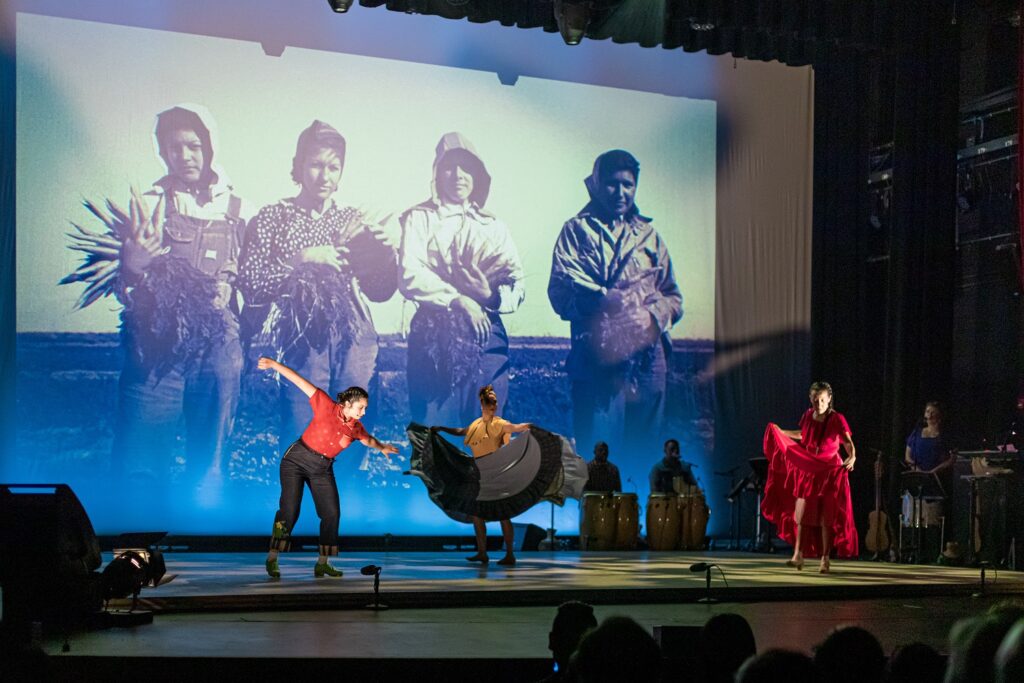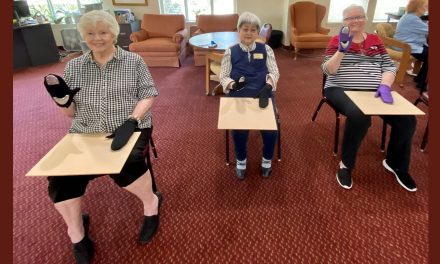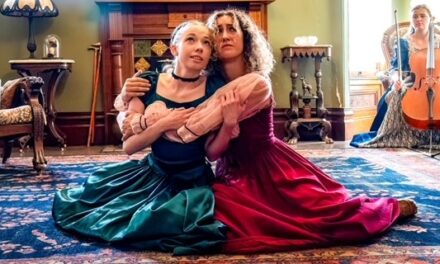Thud, thud, tap, tap.
A quartet of dancers — Sandy Vazquez, Micah Sallid, Kirsten Millan and Casey Tessier — enters the Bovard Auditorium stage, tapping in unison. Their rhythm fills the space with a resounding passion boiling out of their feet. The tempo grows faster, and the world transforms around them in a thud, thud, tap, tap.
As the music joins in on the rhythmic percussion of the dancers’ feet, an honest story about labor workers in the U.S. starts to unfold.
“Ghostly Labor” by Vanessa Sanchez and La Mezcla made its L.A. premiere on September 19 at Bovard Auditorium as part of USC Visions and Voices’ programming. The company’s second full-length touring production weaves together narratives about the history of agricultural and domestic labor workers in the U.S. Sanchez, the executive artistic director of La Mezcal, was inspired by her own family history. The company started working on the piece in 2018 and connected with community organizations (including Ayudando Latinos a Soñar and La Colectiva de Mujeres) and individuals who are “rolling up their sleeves and doing the work every day,” Sanchez said in her director’s note.
The result is a gutsy work full of raw emotion and polyrhythmic sounds that challenge traditional conventions of performance. By meshing tap, Mexican Zapateado, Son Jarocho and Afro-Caribbean dance styles, the La Mezcal musicians and dancers conjure up the history of systemic exploitations of labor in the U.S.
“Ghostly Labor” takes place on a bare stage, but the crew does a great job at worldbuilding. Musicians step forward with Shekeres in their hands, shaking the percussive instrument across the ground as if they are spreading seeds as a field is projected behind them. The dancers follow suit when they enter with pales and brooms in their hands, adding to the musical soundscape when they drum on the pales to create loud thuds and sweep to create a soft shh.
The world they create starts to feel real. Two dancers enter with sticks in their hands, striking the ground as if they are cutting leaves off crops with a machete. They dance and sway between strikes. The reality of this action sets in as the strikes grow so passionate that the final one throws Micah Sallid off balance. Her near fall is not a negative critique. It is a commendable moment that reveals her clear intention and execution of the movement.
“Ghostly Labor” is built out of stories of the past, present and future. In a poignant moment of the work, the company tells the story of Carmelita Torres. Argelia Arreola takes center stage dressed in red. She starts dancing softly, driving her feet down at an easy pace. La Mezcla Artistic Associate Sandy Vazquez steps downstage to share how Torres initiated the 1917 Bath riots on the Mexico-United States border to protest the inspections and chemical baths people went through to enter the U.S. As the story unfolds, Arreola’s passion grows. It’s seen in her eyes and the strength of her grito, or shout.
The present and future collide with interviews of current labor workers projected on a screen. One woman shares how hard it is to work in the fields, that those who complain of expensive vegetables should know that it is, in fact, hard work that brings food to tables across the U.S. In an emotional testimonial, a woman shares the challenges she experienced in migrating to and living in the U.S.
“But I am here,” she says with a smile.
La Mezcla covers a lot of ground and manages to keep you engaged all the way through. However, the intermission adds a road bump to the momentum. It takes a minute for the ensemble to revitalize the energy that drained off the stage. They bring it back by doing what they do best: mixing dance genres with the rhythm as their guide.
Dancers enter with tap shoes but are not performing tap dance techniques. They are stomping their heels against the ground for a Zapateado phrase. As they move, they are both weightless and grounded as they shift between tap and Zapateado phrases.
The dancers start to hop here for the first time. It marks a transition into liberation and joy. They tap their toes against the floor once more before upping the ante. They merge into Zapateado, stomping and driving their heels into the ground. The risk is heightened as the balls of their feet slip and slide.
“Ghostly Labor” demands your attention, ensuring that you aren’t just hearing about labor workers but seeing them and acknowledging their contributions to our everyday lives. By mixing rhythmic dances, La Mezcla tells the story of a community blending and breathing together, all the way to the last percussive strike.
For more information about Vanessa Sanchez and La Mezcla, please visit their website.
To learn more about the Bovard Auditorium, please visit their website.
To learn more about the USC Visions and Voices, please visit their website.
Written by Steven Vargas for LA Dance Chronicle.
Featured image: “Lostly Labor” by Vanessa Sanchez and La Mezcla – Photo by Gina Clyne Photography.











